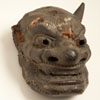Curators' work revealed rare Japanese masks at SMU
Two frightful masks found in an SMU library collection turn out to be very rare Japanese dance drama accessories.

By ERIC AASEN
The Dallas Morning News
Emily George Grubbs didn't know anything about the two dark masks she had pulled out of a tissue-filled box, but one thing was obvious.
"These are really old."
For Grubbs, a curatorial assistant at SMU, questions started percolating. What are these masks? What should we do with them? How did they get here? And how old are they?
The hunt for answers began and details are trickling in.
SMU happens to have Japanese Gigaku masks from the eighth to 10th centuries. There may be about 250 in the world, with only a handful in American museums.
Knowing more about these masks doesn't put Grubbs at ease.
"I'm scared to touch them," she said.
One mask resembles a bird, with a beak and rooster comb on its head. The other looks like an ogre with horns. Some of the masks' top layers have deteriorated, but parts are adorned with red paint from long ago.
When Grubbs unwrapped the masks earlier this year, as she was going through a performing arts collection, a tag was included: "Devil mask from Mexico." But Grubbs thought they looked different from Mexican masks she had seen.
She consulted with SMU colleagues Sam Ratcliffe and Ellen Buie Niewyk.
Over the summer, the archivists-turned-detectives sought advice from John Lunsford, the retired Meadows Museum director. He believed the masks were Japanese.
"He was the code breaker," Niewyk said.
Lunsford suggested they contact Jennifer Casler Price, curator for Asian and non-Western art at the Kimbell Art Museum in Fort Worth.
# # #